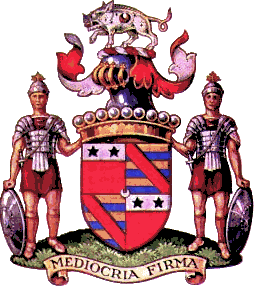

Francis Bacon (1561-1626) English Philosopher and Politician
Baron
Verulam (1618) and Viscount St Albans (1621)
Elizabethan
Proponent of the Scientific Method
Officially, Francis Bacon
was the youngest son of
Sir Nicholas
Bacon (1510-1579) who became Lord Keeper in 1558and whose eldest son (also called Nicholas) was the first person to be created a baronet (in 1611) as mentioned below.
Actually, Francis Bacon may well have been the son of Queen Elizabeth and Robert Dudley.
Quarterly; [1 & 4] Gules, on a chief Argent two mullets Sable;
[2 & 3] Barry of six Or and Azure,
a bend Gules.
[5] Overall, a small crescent Argent in heart.
[Motto Mediocria Firma ]
Roger Bacon (1214-1292)
English Scholar and Franciscan Friar
Early
Proponent of the Scientific Method
Two entries (one Roger Bacon and his son Robert) in the
Armorial
Wijnbergen
(13th century) are
probably related to Roger Bacon (c.1214-1292). Namely:
Gules six roses Argent seeded Or [ a label of four points Azure ].
De gueules à six roses d'argent boutonnées d'or
[ au lambel (4) d'azur ].


